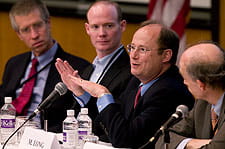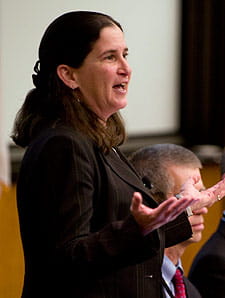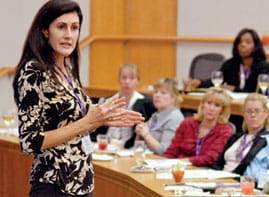Few bright spots on the economic horizon, say participants as they continue the search for alpha, but some see chance for systemic improvement in wake of crisis
11/20/2008 - With another market plunge on Wall Street serving as the backdrop, experts at the Kellogg School’s Finance Conference on Nov. 19 appeared subdued during most of the day’s program.
RELATED VIDEO:
Leo Tilman (Password Protected) |
 |
| Mark Long ‘82 makes a point during a panel discussion at the Nov. 19 Kellogg Finance Conference. Looking on are, from left, Kent Daniel, head of equity research at Goldman Sachs; Taylor O’Malley, chief risk officer, Balyasny Asset Management; and David Marshall, vice president of financial markets group at the Federal Reserve Bank of Chicago. |
| Photo © Nathan Mandell |
 |
| Deborah Lucas, the Donald C. Clark/Household International Professor of Consumer Finance, led a panel discussion at the Nov. 19 Kellogg Finance Conference that explored risks associated with low-probability events. |
| Photo © Nathan Mandell |
As the Dow Jones fell more than 400 points, ending under 8,000 for the first time in nearly six years, the title of keynote speaker Leo Tilman’s presentation — “Financial Darwinism: Create Value or Self-Destruct in a World of Risk” — would have seemed a shot across the bow, if the demise of his former company, Bear Stearns, hadn’t already served that function earlier this year.
Tilman, until recently the chief institutional strategist for Bear Stearns, told attendees that “static business models,” rather than what he called the media’s facile narrative of investor greed and complacency, was most responsible for the current banking crisis.
He said that the “old, blinding ways of thinking” took stock of economic performance largely through the lens of accounting earnings, a perspective that Tilman said was poorly suited to the challenges of a transformed financial landscape that demanded greater skill in assessing risk. By relegating risk management to a secondary concern, however, he said this model lacked even the vocabulary to describe the changes taking place in global markets over the last few years. In addition, the instruments and mechanisms of modern finance — derivatives and securitization, for example — were limited, designed to achieve more narrow business objectives rather than to manage risk, Tilman contended.
As evidence of this strategic stasis, he pointed out that the seeds of the current crisis were planted a quarter century ago and should have been apparent by 2003, when the U.S. government took action that “flooded the market with money.” Inadequate responses from a broad range of stakeholders compounded what Tilman called a systemic failure. Instead of devising new tactics to meet emerging challenges, executives continued employing outmoded ones — a situation he likened to a dinosaur trying to scale a tree with a ladder so that it could reach the higher leaves, after discovering all the low-hanging ones were gone. Meanwhile, the dinosaur fails to comprehend the much larger problem confronting it: a new Ice Age, which demands a far more sophisticated response.
Tilman framed his keynote around concepts in his recent book,
Financial Darwinism, which he called a “road map” to the new financial order. Like others at the sold-out conference, Tilman grappled with the central issue of seeking
alpha — those investments that earn a return even when the market overall is performing poorly. But he emphasized the need to do this in a way that “reconnect[s] risk and strategic business decisions” to creates a holistic framework, something sorely lacking lately.
According to Tilman, market pressures over the past several years demanded continual, even exaggerated, return on investment, which led money managers to respond by taking on greater and greater risk, doing so by “blindly levering up” and borrowing cash that was reinvested in a quest to earn a greater rate of return. When the subprime housing meltdown precipitated a wider liquidity crisis, institutions that were overleveraged found themselves in a “vicious circle” of levering up again and again as they tried to postpone an inevitable day of reckoning.
The daylong conference included three panel discussions and another keynote, but little overt cheer as experts evaluated a financial landscape that they said required a vigorous new commitment to risk management. Still, there were signs that some viewed the crisis as an opportunity for productive change in an industry that has seemed unable to adapt.
While experts on an afternoon panel — “Risk Management in the Era of Black Swans” — doubted that the markets had yet hit bottom, given new announcements of job losses and a historic decline in the Producer Price Index, among other data, they did suggest that better analytical risk modeling, coupled with more rapid response to events, could lead to a revitalized financial sector.
The panel, moderated by Deborah Lucas, the Donald C. Clark/Household International Professor of Consumer Finance, examined risk management strategies, paying special attention to “large-impact and rare events” — so-called “black swans.” Among the panelists’ considerations were implementing beneficial internal processes, gathering better data, and designing incentives. The latter was a topic that panelist Mark Long ’82 said was the “single-most important question.” The vice president and senior relationship manager for Harris Bank said that institutions cannot rely only on a couple key risk managers, but rather that risk awareness must be integrated into every aspect of the organization such that all employees consider it their responsibility.
Panelist Kent Daniel, a former Kellogg finance professor who is now head of equity research for Goldman Sachs’ Quantitative Strategies Group, said his firm tries to manage black swans by using more data to build better forecasting models. “We are very analytical about risk management,” he said. While “often you can’t anticipate” where extreme events will come from, Daniel said that these events always have a cause and that by being cognizant of investment details experts can best position themselves to respond.
While in agreement with this cause-effect view, panelist David Marshall, vice president of financial markets group at the Federal Reserve Bank of Chicago, admitted that “unraveling that cause can be very, very difficult,” due to financial innovations that are, in turn, driven by continual developments in information technology. Innovation creates real problems for risk modeling, said Marshall, a former Kellogg professor. Daniel said that the modeling is challenging and “you’re going to make mistakes,” but that a key strategy is to “immunize your portfolio to the kinds of risks you can identify.”
Marshall also provided his personal insight into the Federal Reserve’s actions in March to facilitate the acquisition of Bear Stearns by JPMorgan Chase. He said that the Fed was under pressure to act quickly to prevent a widespread crisis in the aftermath of the investment bank’s collapse. The Fed did so, said Marshall, but many of his peers shared the view of former Federal Reserve Chairman Paul Volcker who considered the institution to be operating at the “very edge of legal liability” as it engineered the rescue. Given the fundamental market uncertainty, though, Marshall suggested that many people would curtail their investments unless a “sufficient backstop” was provided, either by the Federal Reserve or some other entity, to mitigate the “extreme uncertainty.”
Going forward, Marshall said that one of the Obama administration’s first agenda items should be devising a plan to “rationalize the overall regulatory system.”
Other panels at the conference explored the future of mergers and acquisitions, and trends in alternative investments. Delivering the afternoon keynote was Michael Gross ’87, principal partner of Evanston-based hedge fund Magnetar Capital.
Gross reviewed some of the key drivers of the financial crisis, including the role that cheap credit played in overheating the market. In the spring of 2007, for instance, he said that there was a “tremendous amount of capital looking for work,” which resulted in hedge funds becoming overleveraged. Some of that capital was piled into “a wave of mega-LBOs,” many of the leveraged buyouts topping $10 billion per transaction. Gross said that the “twin storms” that have sent investors diving for cover today were the subprime meltdown and rampant leveraged lending.
But he said that there is little for private equity professionals to do now but ride out the storm. “If you’re a private equity firm today, there’s nothing to invest in. You can’t borrow money effectively to do so,” said Gross. “You will have to sit on the sidelines and wait [for the market to recover]. It’s not going to be a fun thing to do.”
Gross also predicted a “massive consolidation” in his industry over the next few years, which will find asset managers who have remained focused on their core expertise doing better than those who scattered their resources. “Size does matter here,” Gross said, saying the shakeout will be a “survival of the fittest” and that those managers with significant assets under management are likely to have the resources and risk management systems to outlast the crisis.
For the near-term, though, Gross told the audience, which included many Kellogg students, that “It’s a good time to be in school.”
Professor Lucas noted an overall “cautious optimism” in how conference participants regarded the economic crisis. “Many of the speakers seemed to find opportunities in the current chaos, and said that there will be even more going forward. I agree,” she said.
Lucas, one of the Kellogg finance thought leaders who has been analyzing the U.S. banking crisis in recent months, also said that the conference offered hope that “many of the excesses of the past may finally be reined in.”
Her colleague Robert Korajczyk, the Harry G. Guthmann Professor of Finance and director of the Kellogg School’s Zell Center for Risk Research, praised the student organizers of the conference for selecting important and timely topics, months in advance of the liquidity crisis.
“The discussions at the conference really pointed to an important shift in the manner in which firms, as well as regulators, will approach risk management in the future,” Korajczyk said. “This includes rethinking the effects of incentives on risk-taking and improving the integration of economic analysis into quantitative and qualitative approaches to risk management.”






